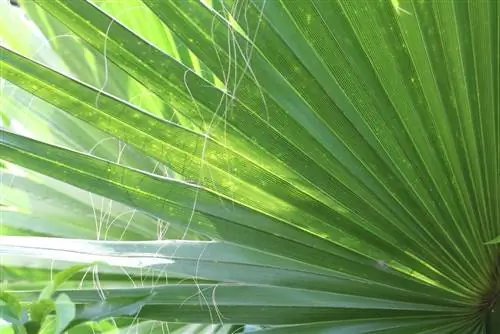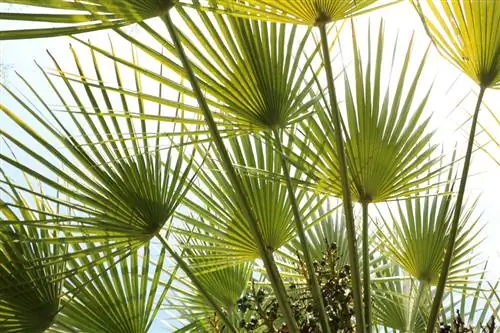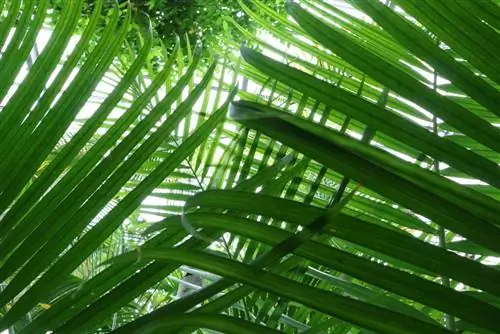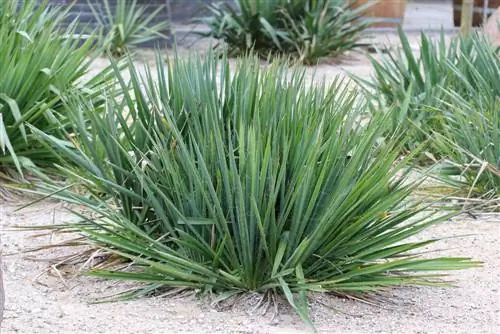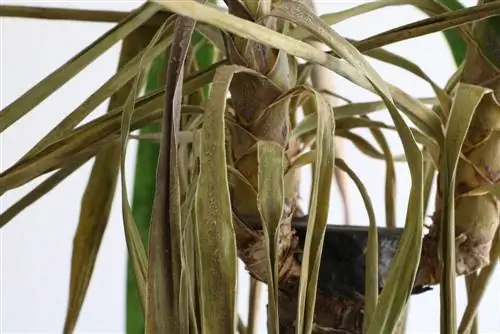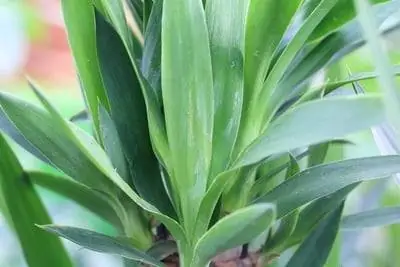- Author admin [email protected].
- Public 2023-12-17 03:39.
- Last modified 2025-01-24 12:45.
The Washington palm has the botanical name Washingtonia robusta and belongs to the palm family. The plant is also colloquially known as the petticoat palm due to its unusual growth habit. To ensure beautiful and he althy growth, certain factors must be taken into account when caring for them. In addition, the palm tree is only partially hardy, so it is better to keep it in a pot as a houseplant.
Location
The Washington palm comes from northern Mexico and therefore thrives best with plenty of sunlight and warmth. The more sun the plant receives throughout the day, the greener the palm fronds become. The palm tree reacts very sensitively to certain site conditions, which is why these must always be taken into account when selecting a location. If the plant is too dark, the leaves growing below will quickly be lost. If you keep it as a houseplant, it is a good idea to move it to a protected outdoor location for the warmer summer season. However, after the winter rest phase, the Washington palm should first be slowly accustomed to the stronger light conditions outdoors. If the plant is exposed to the intense midday heat too quickly, unsightly burns can occur on the palm fronds.
- Very bright to full sun location is ideal
- Optimal temperature values are between 20° to 25° Celsius
- Cool and dark places are not tolerated well
- Avoid long-term cold drafts
- Prefers high humidity, spray regularly with water mist
- Summer over the summer either on the balcony, terrace or in the garden
- Initially place in a partially shaded spot for two weeks
- Then move to the final location in the sun
Planting substrate
Since Washingtonia robusta gets the nutrients it needs from the plant substrate, it depends on a harmonious relationship with the soil. If the composition is not right, the palm tree cannot develop properly and often grows very poorly.
- Needs loose and water-permeable plant substrate
- Conventional potting soil is not suitable
- Special palm soil from specialist retailers is perfect
- Pay attention to nutrient-rich, low-lime and sandy properties
- Good is a neutral to slightly acidic pH value
Tip:
If the planting substrate is enriched with perlite, then it is much looser. The additional addition of lava granules also improves water storage in the soil.
Plants
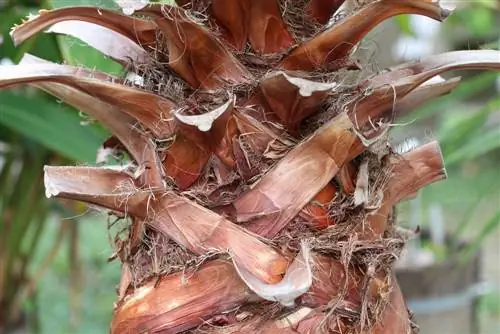
The Washington palm grows quite quickly and lushly, so it is recommended to use a larger planter when planting for the first time. The circumference of the pot should be at least a third larger than the root ball. However, the planter must not be too large, otherwise the petticoat palm will find it difficult to establish itself well in it. Since Washingtonia robusta grows tall and develops long roots, tall planters are best suited for the palm tree. In addition, waterlogging in the vessel should be avoided.
- Lay drainage over the drain hole in the vessel
- Gravel, quartz sand or pottery shards are ideal
- When potting, make sure the plant is aligned straight
- Cover the upper root area with 3 cm of soil
- After planting, press the top layer of soil well
- Then water well, but don't keep it too wet
Pouring
When watering, the petticoat palm has relatively high requirements that must be met permanently. Otherwise, dried leaves can occur and, in extreme cases, the plant can even die completely. Since the Washington palm grows extremely quickly, it needs a lot of water. The warmer it gets over the course of the year, the more often the plant needs to be watered.
- Water regularly and abundantly
- Root ball must never dry out completely
- Place the palm tree in a large saucer and water it again and again
- Water twice a day during hot dry periods
- Only use low-lime irrigation water, rainwater is ideal
- Alternatively use stale tap water
- But does not tolerate waterlogging
- Lower water requirement in winter
Fertilize
The Washington palm needs lots of nutrients for he althy and strong growth. Therefore, the plant must be supplied with a nutrient-rich fertilizer during the vegetation phase. If many leaves fall off at once, this is often an indication of an urgent need for fertilizer due to a nutrient deficiency. If space is limited at the location, both fertilizer and water applications should be reduced. In this way, the growth habit of the Washington palm is kept manageable.
- Fertilize from April to late autumn
- Liquid fertilizer is ideal for palm trees
- Use fertilizer every three to four weeks
- Proceed according to dosage instructions
- Adjust fertilizer doses in winter
Repotting
Repotting every three to four years is usually enough. However, if the site conditions and care are perfect, the Washington palm grows much more quickly. This means that repotting becomes necessary much earlier, sometimes even every year, but at the latest every two years. The rapid growth results in a lack of space, so that the plant can no longer develop undisturbed. In addition, the plant substrate is used up, which should be regularly replaced with fresh soil. However, you should only repot if the pot has become too small. This is the case when the first root tips protrude from the top of the planter or grow through the drainage hole at the bottom. If growth control is desired, all root parts must be shortened by at least a third.
- The ideal time for repotting is spring
- Choose a larger but not too big vessel
- Make sure the bucket is sufficiently deep
- Carefully dig up the plant and remove the old substrate from the roots
- Cut off extremely soft, rotting and soggy root pieces
- Plant in fresh palm soil
- Alternatively use enriched plant substrate
- Good, but don't water too much
Tip:
If it becomes apparent when repotting that the roots of the Washington palm are extremely dry, then a refreshing water bath will help. To do this, immerse the root ball in a bucket of water until no more air bubbles appear.
Cutting
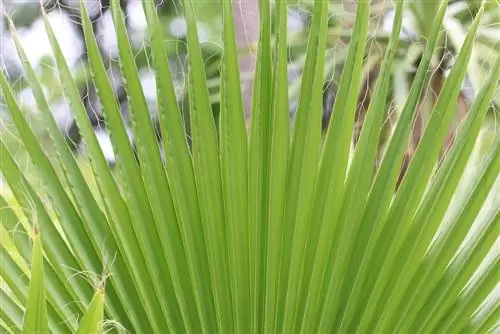
The Washingtonia robusta only has one individual vegetation point from which the leaves grow in a fan shape. For this reason, it is not possible to restrict growth by cutting back the old leaves. Therefore, shaping pruning is not necessary. In the lower area, the dried leaves of younger specimens are not shed; they hang downwards as a petticoat. This fact has given the palm tree its unusual nickname.
- Cut off diseased and dry plant parts
- Short the lower petticoat leaves on houseplants
- But only when they turn gray-brown
- To limit growth as desired, trim roots regularly
- Ideally done when repotting when roots are exposed
Wintering
The Washington palm is not completely hardy in these latitudes. The robust plant can tolerate cool temperatures and low frost levels, but temperatures that are too low below zero lead to the palm dying. For this reason, the petticoat palm is kept as a houseplant that can spend the summer in an outdoor location. However, Washingtonia robusta should not overwinter in permanently heated living spaces. Since there is always a combination of warm heating air and low humidity with little sunlight, the plant becomes very susceptible to certain diseases and pest infestation. In the much warmer wine-growing regions, the Washington palm can be kept outdoors all year round, but only in a protected place and with additional winter protection.
- Is only conditionally hardy
- Can survive short-term temperatures down to -5° Celsius
- Still sprouts leaves at 5 to 10° Celsius
- Moving into winter quarters from the first frosty nights
- Frost-free winter gardens and greenhouses are ideal for overwintering
- Water significantly less in winter
- Root ball must never dry out completely
- The cooler the winter quarters are, the lower the water requirement
- In warmer locations the light and water requirements increase
- Spray regularly with water mist in dry places
- Do not fertilize in the winter months
Propagate
It is not possible to propagate the Washington palm using cuttings, so sowing is the only option. The chances of success are relatively high if the right steps are followed and the seed quality is right. After flowering in spring, seeds are formed. When these turn dark, the seeds are ripe enough to sow. In addition, seeds are also available from specialist retailers so you can grow Washingtonia robusta yourself.
- The ideal time for sowing is May to June
- Seeds should already be black-brown and at least 5 mm tall
- Soak seeds in water for a day
- Fill the container with potting soil
- Press seeds 5-10 mm into the substrate, then cover loosely with soil
- Water the substrate and keep it evenly moist
- Put transparent film over the planter
- Place in a bright location, but out of direct sunlight
- Optimal temperature values are between 22° - 30° Celsius
- Germination occurs after 2-12 weeks, depending on the conditions
- Prick out young plants from a height of 20 cm
Diseases
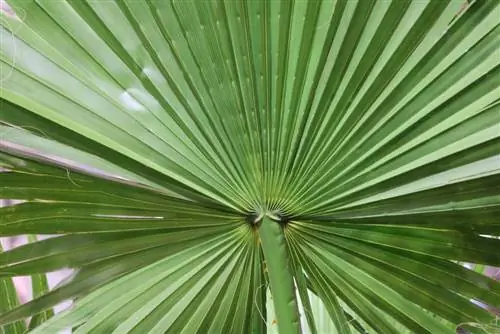
Washingtonia robusta has its meaningful name for a reason; the plant is very robust against most diseases. However, errors in care quickly creep in, which can cause considerable damage to the plant. These include a poorly selected location, a permanent lack of nutrients or a plant substrate that is consistently too wet. The consequences of the petticoat palm are yellow leaves and limited growth. Constant waterlogging caused by overwatering can lead to root rot, which can cause the death of the plant. In addition, too much moisture promotes the formation of mold in the plant pot.
- Susceptible to fungal diseases if the immune system is weakened
- Mushrooms appear through colored coating on the leaves
- Phoenix smut fungus can be recognized by small knots on the palm fronds
- Inject with fungicide for a few weeks
- In case of extremely severe infestation, cut off entire leaves
- Dispose of in household waste and not in the compost
Pests
If the palm tree's winter quarters are too warm, pest infestation often occurs. The plant should therefore be checked regularly in the winter in order to detect any infestation promptly. The sooner this happens, the easier it will be to fight the pests afterwards.
- Susceptible to aphids, spider mites, mealybugs and scale insects
- Wash off pests with soapy water
- If there is a heavy infestation, hose it down extensively in the shower
- Repeat process if necessary
Tip:
Regular spraying with decalcified water acts as a preventive measure against pest infestation.

